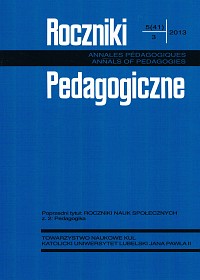Cognitive Abilities of Hard Heating Pupils and their Integration in Public Schools
Main Article Content
Abstract
The question of cognitive abilities of hard of hearing pupils is one of the most important problems encountered by surdopedagogy. Over the years various answers have been given to this question. Initially a hearing defect was identified with a lack of intellectual abilities, whereas studies conducted in recent years show that also in this population there are people with a high and very high intellectual potential.
The aim of the present article is to present modern studies of the intellectual abilities of hard of hearing pupils and to point to their consequences for educational integration of this group of pupils. The presented studies show that pupils with hearing defects generally have the potential that should allow them to function well in the intellectual sphere among their hearing coevals. However, the condition for success in the sphere of educational integration is aiding the hard of hearing pupil in a systematic and competent way, starting with very early years of his life.
Article Details
References
Astington J. (2001): The future of theory-of-mind research: Understanding motivational states, the role of language, and real-world consequences. „Child Development” 72, s. 685-687.
Courtin C., Melot A.M. (1998): Development of theories of mind in deaf children. W: M. Marschark, N.D. Clark (eds.), Psychological perspectives on deafness (vol.2, s.79-102). Mahwah, NY: Lawrence Erlbaum.
Csányi Y. (1994): Słuchowo-werbalne wychowanie dzieci z uszkodzonym narządem słuchu. Model węgierski. Warszawa.
Czajkowska-Kisil M. (2008): Pułapki metodologiczne w badaniach PJM. W: Stan badań nad Polskim Językiem Migowym (s.11-16). Łódź: Polski Związek Głuchych.
De Villiers P.A., Pyers J. (2000): Complementation and false-belief representation. W: Proceedings of the VIIIth International Congress for the Study of Child Language, Spain.
Dunn J. (1994): Changing minds and changing relationships. W: C. Lewic, P.Mitchell (eds.). Origins of an understanding of mind (s. 297-310). Hove, England: Erlbaum.
Dunn L.M., Dunn L. (1981): Peabody Picture Vocabulary Test, Revised edition. Circle Pines, MN: American Guidance Service.
Emmorey K., Klima E., Hickok G. (1998): Mental rotation within linguistic an nonlinguistic domains in users of American Sign Language. „Cognition” 68, s.221-246.
Furth H.G. (1966): Thinking without Language. Psychological Implications of Deafness. New York: The Free Press.
Gałkowski T. (1976): Psychologiczne aspekty głuchoty w audiologii. W:T.Gałkowski, I. Kunicka-Kaiser, J. Smoleńska (red.), Psychologia dziecka głuchego (s.5-41). Warszawa: PWN.
Geers A. (2006): Spoken language in children with cochlear implants. W: P.E.Spencer, M. Marschark (eds.), Advances in spoken language development of deaf and hard of hearing children (s.244-270). New York: Oxford University Press.
Gordon A.C., Olson D.R. (1998): The relations between acquisition of a theory of mind and the capacity to hold in mind. „Journal of Experimental Child Psychology” 68, s. 70-83.
Krakowiak K. (1995): Fonogesty jako narzędzie formowania języka dzieci z uszkodzonym słuchem (Komunikacja językowa i jej zaburzenia, t.9). Lublin: UMCS.
Lang H.G., Meath-Lang B. (1995): Deaf persons in the arts and sciences: A biographical dictionary. Westport, CT: Greenwood Press.
Maller S.J. (2003): Intellectual assessment of deaf people. A critical review of core concepts and issues. W: M. Marschark, P.E. Spencer (eds.), Oxford handbook of deaf studies, language and education. Oxford: Oxford University Press.
Marschark M. (1993): Origins and interactions in language, cognitive and social development of deaf children. W: M. Marschark, M.D. Clark (eds.), Psychological perspectives on deafness (s. 7-26). Hillsdale, NY: Lawrence Erlbaum Associates, Inc.
Marschark M., Clark M.D. (1998): Psychological perspectives on deafness (t. 2). Mahwah, NY: Lawrence Erlbaum.
Marschark M., Green V., Hindmarsh G., Walker S. (2000): Understanding theory of mind in children who are deaf. „Journal of Child Psychology and Psychiatry” 41, 8, s.1067-1073.
Marschark M., Lang H.G., Albertini J.A. (2002): Educating deaf students: From research to practice. New York: Oxford University Press.
Marschark M., Spencer P.E. (eds.) (2003): Oxford handbook of deaf studies, language and education. New York: Oxford University Press.
Moores D.F. (1982): Educating the deaf. Boston: Houghton Mifflin.
Moores D.F. (1996): Educating the deaf. Psychology, principles and practices. Boston: Houghton Mifflin.
Myklebust H.E. (1964): The psychology of deafness. New York: Grune & Stratton.
Padden C.A., Hanson V.L. (2000): Search for the missing link: the development of skilled reading in deaf children. W: K. Emmorey, H. Lane (eds.), The signs of language revisited (s. 435-438). Mahwah, NY: Lawrence Erlbaum Associates.
Perier O. (1992): Dziecko z uszkodzonym narządem słuchu. Warszawa: Wydawnictwa Szkolne i Pedagogiczne.
Peterson C.C., Siegal M. (2000): Insights into theory of mind from deafness and autism. „Mind and Language” 15(1), s.77-99.
Prillwitz S. (1996): Język, komunikacja i zdolności poznawcze niesłyszących. Warszawa: Wydawnictwa Szkolne i Pedagogiczne.
Rothman N., Sadler-Hormazabal T. (1999): Literature based classroom: Strategies to develop critical thinking skills. Paper presented at the conference on Literacy and Education: Empowering Deaf, Hard-of-Hearing and Deaf-Blind Youth. Melville, NY, November 3.
Schick B., de Villiers J., de Villiers P., HoffmeisterR.(2007): Language and theory of mind: A study of deaf children. „Child Development” 78, 2, s.376-396.
Spencer P.E. (2000): Looking without listening: Is audition a prerequisite for normal development of visual attention during infancy? „Journal of Deaf Studies and Deaf Education” 5, s.291-302.
Stachyra J. (2001): Zdolności poznawcze i możliwości umysłowe uczniów zuszkodzonym słuchem. Lublin: UMCS.
Stokoe W.C. (1960/2005): Sign language structure: an outline of the visual communication systems (Studies in Linguistics, Occasional Papers 8). Buffalo, NY: University of Buffalo; reprint w: „Journal of Deaf Studies and deaf Education” 10, s.3-37.
Szczepankowski B. (2009): Wspomaganie rozwoju dziecka niesłyszącego. Audiofonologia pedagogiczna. Warszawa: Wydawnictwo UKSW.
Vernon M. (1968/2005): Fifty years of research on the intelligence of the deaf and hard of hearing children: A review of literature and discussion of implications. „Journal of Rehabilitation of the Deaf” 1, s.225-231.
Zielińska J. (2007): Edukacja dzieci z uszkodzeniem słuchu w społeczeństwie informacyjnym. Toruń: Adam Marszałek.
